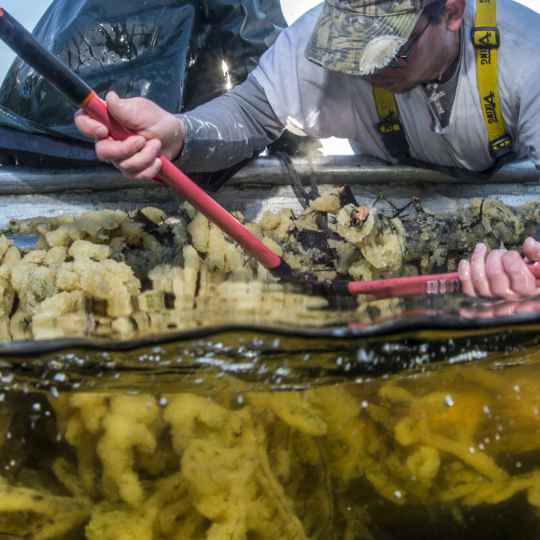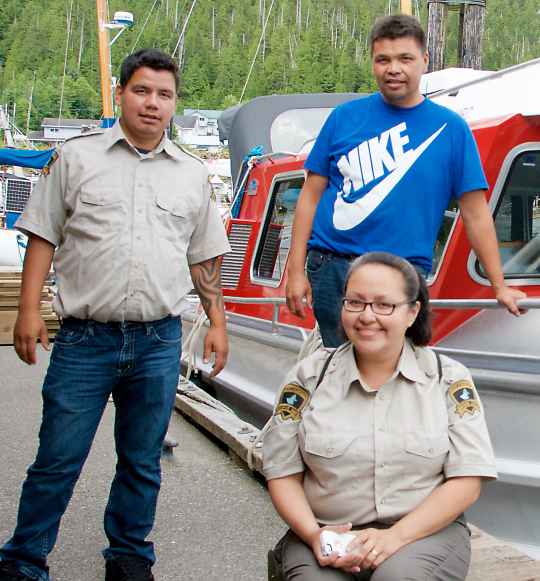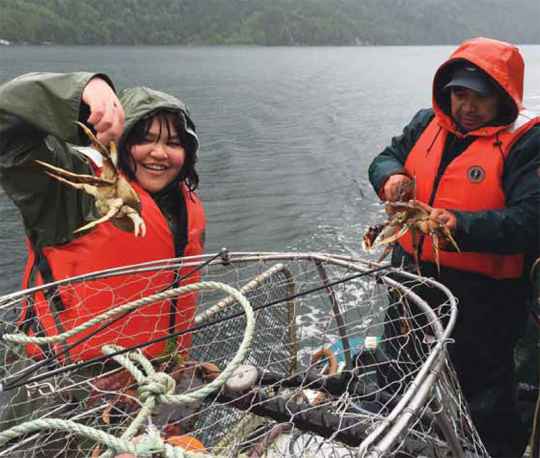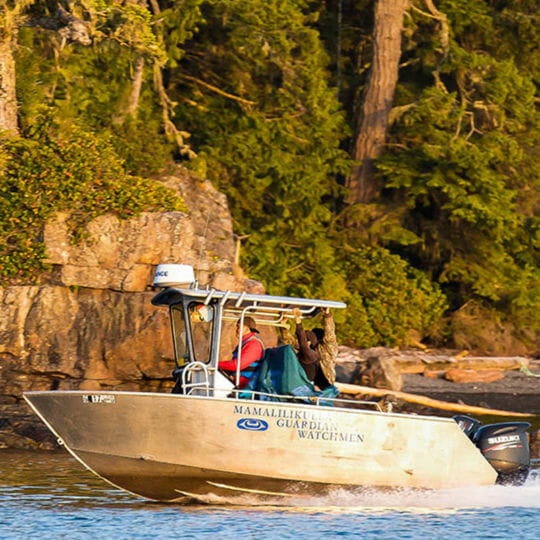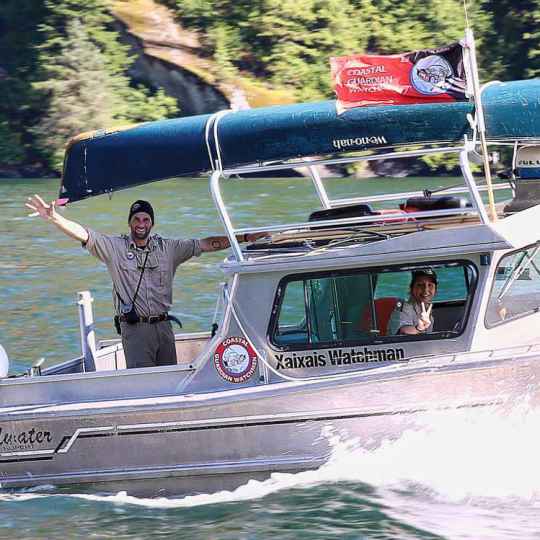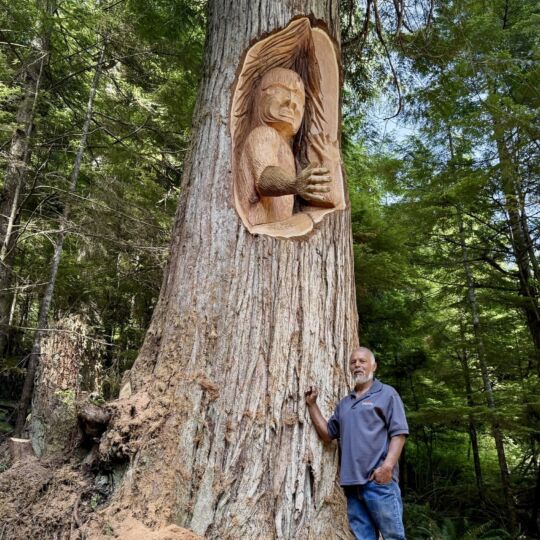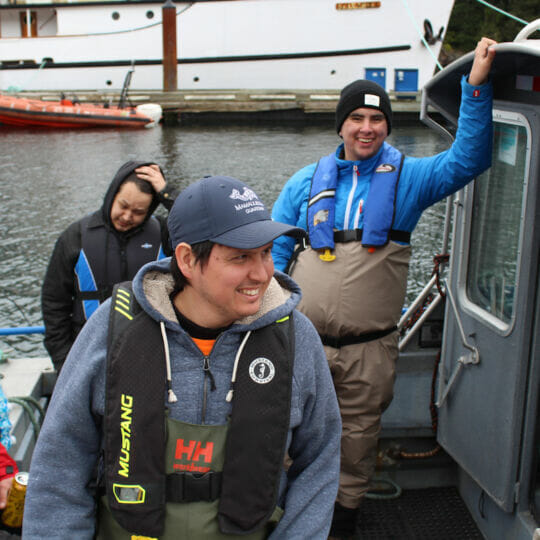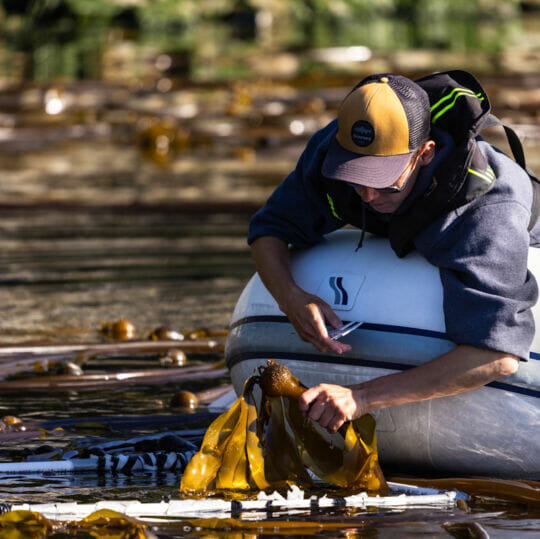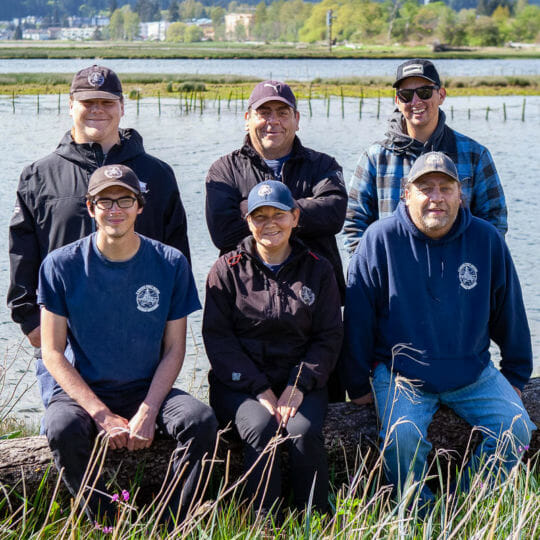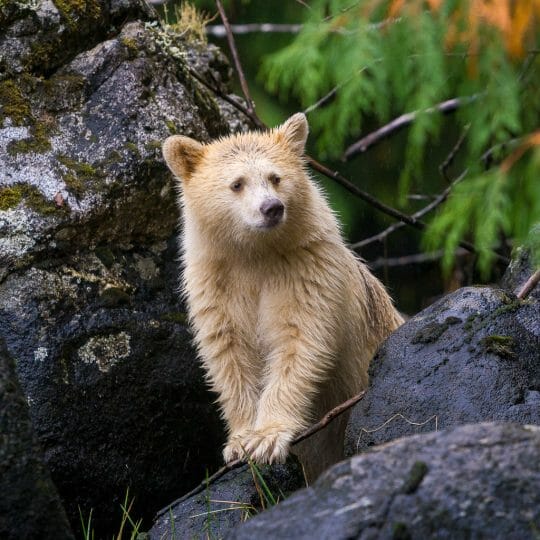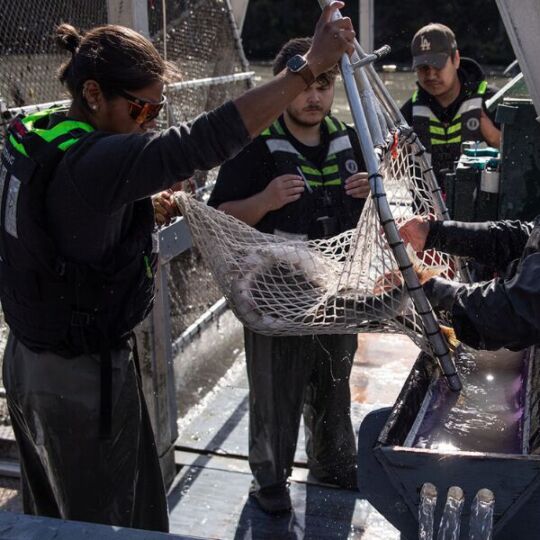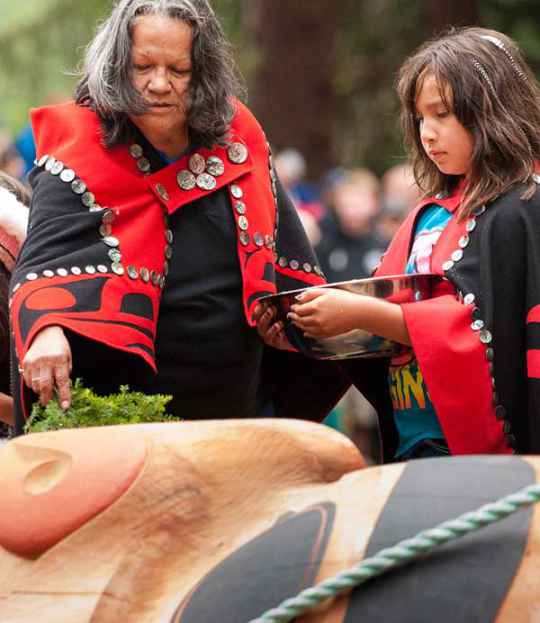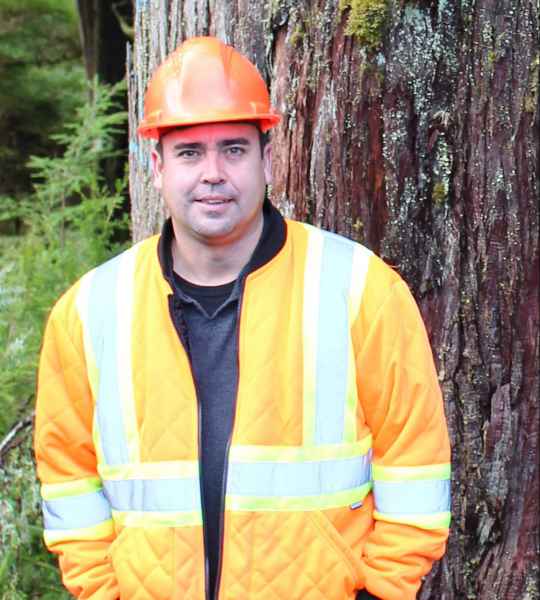Environmental Conservation
First Nations are leading conservation and research initiatives in the Great Bear Rainforest and Haida Gwaii to protect and sustain the ecological integrity of the region.
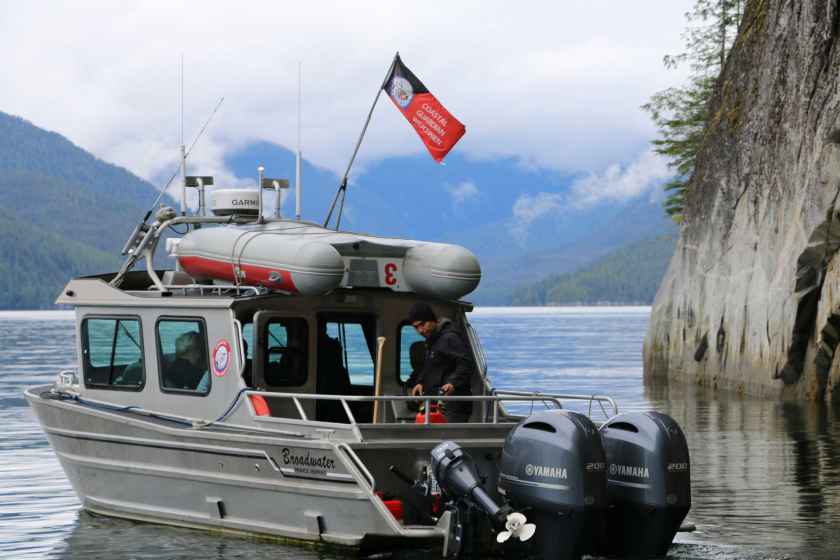
The Great Bear Rainforest and Haida Gwaii regions of British Columbia encompass the largest intact coastal temperate rainforest remaining in the world. First Nations have sustainably managed the abundant resources and ecosystems of this unique region for thousands of years.
Today, First Nations continue to lead conservation efforts in the region by combining traditional stewardship practices with modern science and regional monitoring that protects and restores ecological integrity across the coast. First Nation initiatives are resulting in robust research, habitat protection and restoration, and monitoring of key species and resources. These programs help to protect First Nations’ values and traditions, ensuring that resources and natural surroundings are sustained for future generations.
Environmental Conservation Outcomes
First Nations are working collaboratively with each other and the Province of British Columbia to develop management plans for designated protected areas.
Developing Management Plans
First Nations have published 27 protected area management plans through investments with Coast Funds. These plans prescribe how important ecological areas, cultural features, and traditional harvesting sites will be conserved for future generations.
Community Well-Being Impact
First Nations are engaging with British Columbia’s Ministry of Environment (BC Parks) on a government-to-government basis to develop management plans that affirm the significance of protected areas and provide guidelines for preserving important ecological and cultural values.
These plans outline cultural features, archeological sites, harvesting sites, and ecologically sensitive areas, ensuring that they can be protected and maintained for current and future generations. By establishing management plans, First Nations and the provincial government have guidelines to regulate activities that can occur within protected areas.
We completed five drafts of conservancy management plans for areas of environmental and cultural importance to the Gitga’at people.
— Chris Picard, Science Director, Gitga'at First Nation
Related Stories
Heiltsuk Stewardship: Collaborating for Resource Management
The Heiltsuk Nation is ensuring that community voices are heard and important resources are protected through their stewardship work.
Gitga’at Guardians: Using Science to Safeguard their Territory
The Gitga’at Nation is protecting ecosystems, wildlife, and cultural assets in their territory through monitoring and research.
Gitga’at Guardians: Sustaining a Way of Life
The Gitga’at Guardians protect the remote territory of the Nation while providing local employment opportunities.
National Geographic Features Kitasoo/Xai’Xais Nation and Spirit Bear Lodge
Estimated Reading time

2 Mins
In 1999 Kitasoo/Xai’xais launched Spirit Bear Lodge from a little red-roofed float house anchored at Klemtu’s docks. Today a luxurious new lodge accommodates visitors from around the world, most of whom come to tour the nearby islands in hope of spotting and photographing bears.
Raising Up The Next Generation Of Great Bear Rainforest Stewards
Estimated Reading time

2 Mins
An excellent new feature in Nature Conservancy Magazine explores how the Supporting Emerging Aboriginal Stewards program of the Kitasoo/Xai’xais Nation not only brings life-changing experiences to young people but also represents a strategic investment in conservation.
State of the Gitga’at Ocean Report
Estimated Reading time

2 Mins
The State of the Gitga’at Ocean Report aims to present Gitga’at members, leaders and research partners with the outcomes of key monitoring activities that have been occurring in the territory in recent years.
First Nations are proactively managing protected areas in the Great Bear Rainforest and Haida Gwaii to preserve and enhance the ecological integrity of the region.
Managing Protected Areas
First Nations conducted conservation and stewardship work in 133 protected areas in the Great Bear Rainforest and Haida Gwaii through investments with Coast Funds.
Community Well-Being Impact
There were 195 separate conservancies, parks, and protected areas established within the Great Bear Rainforest and Haida Gwaii as of December 31, 2021. These areas include important animal habitats, sensitive ecosystems, and First Nations’ cultural and heritage sites.
First Nations are taking an active role in protection of these areas through land- and marine-based stewardship, research and restoration initiatives, preparing protected area management plans, and regional monitoring activities. Managing protected areas reinforces First Nations’ connection to their territory and helps to sustain cultural features and resources for the future.
We completed conservancy work including bivalve and crab assessments and research on potential harvest and oil spill impacts so we can protect important areas.
— Kyle Clifton, Environmental Assessment Officer, Gitga’at First Nation
Related Stories
A Feather in the Forest: Haida Researchers Race to Protect Endangered Stads K’un (Northern Goshawks)
Haida surveyors and stewardship staff, along with biologists and researchers, are racing to identify and protect critical old growth forest habitat for the last remaining stads k’un, a subspecies of Northern goshawk that’s unique to the island archipelago.
Mamalilikulla Guardian Watchmen: Fulfilling Ancestral Responsibilities for the Benefit of Future Generations
The Mamalilikulla Guardians are re-asserting the Nation’s presence in their territories, conducting research and restoration, monitoring industrial and recreational activity, and protecting cultural assets. With the Nation’s 10-year stewardship vision, they are mapping a path forward to do even more.
Return to the Homelands: Establishing the Gwa’sala-’Nakwaxda’xw Guardian Watchmen Program
After a forced relocation separated the Gwa’sala-‘Nakwaxda’xw Nations from their homelands, the creation of a Guardian Watchmen program is helping strengthen the Nations’ stewardship practices and cultural connections.
Old Massett Village Council: Transforming a Haida Village Site
Old Massett Village Council’s promising new venture, Hiellen Longhouse Village, is providing ecotourism experiences of visitors to Haida Gwaii, creating jobs and training for locals, and hosting events that contribute to the Haida Nation’s ongoing cultural revitalization.
Coastal Stewardship Network: Collaborative Monitoring and Protection of First Nations’ Lands and Waters
The Coastal Stewardship Network is supporting its member First Nations as they’ve established sophisticated monitoring programs and their analyses informing vital environmental and resource management decisions.
Gitga’at Guardians: Using Science to Safeguard their Territory
The Gitga’at Nation is protecting ecosystems, wildlife, and cultural assets in their territory through monitoring and research.
First Nations are protecting their territories through regional monitoring programs that patrol, survey, and collect valuable data from land and ocean environments with funding support from Coast Funds.
Guardian Watchmen Programs
First Nations have used funds to support the operations of 18 unique regional monitoring and Guardian Watchmen programs, covering an average area of 7.5 million hectares annually.
Keepers of the Coast is a documentary film by the Central Coast Indigenous Resource Alliance that takes a close look at how the Kitasoo/Xai’xais, Heiltsuk, Nuxalk, and Wuikinuxv Nations are stewarding their marine territories.
Community Well-Being Impact
For thousands of years, First Nations have been caretakers of the Great Bear Rainforest and Haida Gwaii, managing natural resources to ensure they were not depleted. Today, First Nations are continuing this vital role as proactive stewards of their territories through regional Guardian Watchmen programs.
Working with fisheries, forestry, and parks as technicians, guardians, and rangers, First Nations contribute to the successful implementation of land and marine use plans and other sustainable resource management initiatives. By monitoring activities for ecosystem-based management, First Nations are ensuring a vibrant future with continued access to the rich resources of the territory.
Our Guardian program has been incredible for our Nation to be able to visit remote parts of our territory and original communities that have been inaccessible for years. It also enables us to collect data to ensure the next generation are going to have the same resources we have today.
— Sherry Thomas, Band Administrator, Tlowitsis First Nation
Related Stories
Kwakwa̱ka̱ʼwakw Carvers Uphold Millennia-Old Traditions
First Nations carvers are working with wilkw / k ̓ wa’x̱ tłu Large Cultural Cedar to create cultural works, like an ocean-going xwax’wa̱na, that celebrate the revival of traditions.
Ha-ma-yas Stewardship Network Supports Guardians, Collaboration
Through Ha-ma-yas, Na̲nwak̲olas member First Nations are pooling resources and increasing their access to training, fundraising, procurement, and data storage, and technical expertise.
Wei Wai Kum Guardians: In the Steps of Our Ancestors
For millennia, the Wei Wai Kum, part of the Laich-Kwil-Tach group of First Nations, have watched over and cared for the lands and waters in their territory. Today, the Nation’s Guardians combine traditional knowledge with scientific tools to carry out that responsibility in a modern way, bringing their findings back to decision makers.
Mamalilikulla Guardian Watchmen: Fulfilling Ancestral Responsibilities for the Benefit of Future Generations
The Mamalilikulla Guardians are re-asserting the Nation’s presence in their territories, conducting research and restoration, monitoring industrial and recreational activity, and protecting cultural assets. With the Nation’s 10-year stewardship vision, they are mapping a path forward to do even more.
K’ómoks Guardians: Caretakers for the Land of Plenty
K’ómoks First Nation have stewarded the lands and waters of their vast territory since time immemorial. Today, that ancestral responsibility is carried out in large part by the K’ómoks Guardian department.
Return to the Homelands: Establishing the Gwa’sala-’Nakwaxda’xw Guardian Watchmen Program
After a forced relocation separated the Gwa’sala-‘Nakwaxda’xw Nations from their homelands, the creation of a Guardian Watchmen program is helping strengthen the Nations’ stewardship practices and cultural connections.
First Nations are leading research to assess and restore habitats, protecting species of special concern in a wide range of ecosystems found throughout the Great Bear Rainforest and Haida Gwaii.
Scientific Research and Habitat Restoration
First Nations have conducted 444 scientific research or habitat restoration initiatives, through investments with Coast Funds, on 77 different species, including whales, bears, wolverines, salmon, herring, and more.
Community Well-Being Impact
The Great Bear Rainforest and Haida Gwaii region is one of the richest biodiversity areas in the world. First Nations are working to protect this resource with habitat-oriented science that examines the ecological conditions for species to be protected.
Through species enumeration, invasive species management, stream assessments, water sampling, zooplankton analysis, biotoxicity monitoring, and other ecosystem science, First Nations are ensuring the delicate and productive ecology of the region is maintained.
Bears are culturally and economically significant to the Kitasoo/Xai’xais people. Using non-invasive hair snagging, we have been studying the population dynamics and distribution of bears in our territory so that we can better understand their movement and how to protect them.
— Doug Neasloss, Chief Councillor, Kitasoo/Xai’xais First Nation
Related Stories
A Feather in the Forest: Haida Researchers Race to Protect Endangered Stads K’un (Northern Goshawks)
Haida surveyors and stewardship staff, along with biologists and researchers, are racing to identify and protect critical old growth forest habitat for the last remaining stads k’un, a subspecies of Northern goshawk that’s unique to the island archipelago.
Ha-ma-yas Stewardship Network Supports Guardians, Collaboration
Through Ha-ma-yas, Na̲nwak̲olas member First Nations are pooling resources and increasing their access to training, fundraising, procurement, and data storage, and technical expertise.
Wei Wai Kum Guardians: In the Steps of Our Ancestors
For millennia, the Wei Wai Kum, part of the Laich-Kwil-Tach group of First Nations, have watched over and cared for the lands and waters in their territory. Today, the Nation’s Guardians combine traditional knowledge with scientific tools to carry out that responsibility in a modern way, bringing their findings back to decision makers.
The Saviour Fish: Protecting Nisga’a Connection to Oolichan
After Ḵ’alii Aksim Lisims (Nass River) oolichan were designated a species-at-risk, the Nisg̱a’a Lisims Government undertook a multi-year research project that would protect their connection to the culturally important fish.
The Success of Spirit Bear Lodge: How a Remote, Community-led Business Became a Global Model for Ecotourism
Spirit Bear Lodge, owned and operated by Kitasoo/Xai’xais Nation, has become a successful model for conservation-based ecotourism. The Lodge has helped strengthen economic, conservation, and cultural well-being in the community of Klemtu.
Coastal Stewardship Network: Collaborative Monitoring and Protection of First Nations’ Lands and Waters
The Coastal Stewardship Network is supporting its member First Nations as they’ve established sophisticated monitoring programs and their analyses informing vital environmental and resource management decisions.
First Nations work with the Province of British Columbia to assess all applications for proposed commercial activities in the region.
Regulating Commercial Activities
First Nations operate 18 referral programs that are connected with Coast Funds-supported stewardship initiatives. These referral programs assess at least 3,821 applications each year for commercial land, marine, or resource use in the region using First Nations’ land use planning, cultural, and resource data.
| Referrals Processed by First Nations directly related to Coast Funds projects | |
|---|---|
| First Nation | Conservation Office that Evaluates Referrals |
| Da’naxda’xw Awaetlala | Na̲nwak̲olas Council Society |
| Gitga’at | Gitga’at Oceans and Lands Department |
| Gitxaala | Gitxaala Nation |
| Gwa’sala- |
Gwa’sala-‘Nakwaxda’xw Nation |
| Haida | Haida Solutions Table, Haida Gwaii Management Council |
| Haisla | Haisla Natural Resources Department |
| Heiltsuk | Heiltsuk Integrated Resource Management Department |
| Kitasoo Xai’xais | Kitasoo Resource Stewardship Program |
| K’omoks | Na̲nwak̲olas Council Society |
| Kwiakah | Na̲nwak̲olas Council Society |
| Lax Kw’alaams | Lax Kw’alaams Band |
| Mamalilikulla | Na̲nwak̲olas Council Society |
| Metlakatla | Metlakatla Stewardship Society |
| Nuxalk | Nuxalk Integrated Resource Office |
| Tlowitsis | Na̲nwak̲olas Council Society |
| We Wai Kai Nation | We Wai Kai Nation |
| Wei Wai Kum Nation | Na̲nwak̲olas Council Society |
| Wuikinuxv | Wuikinuxv Resource Stewardship Office |
Community Well-Being Impact
First Nations referral offices take a leading role in evaluating development applications proposed within First Nations territories. Applications are submitted to First Nations by the Province of British Columbia. The First Nations’ referral offices are often comprised of a multi-disciplinary team within First Nations’ integrated stewardship departments who evaluate proposals and provide the Nations’ leadership with advice on how proposed commercial activities may affect existing the Nations’ land use planning, important cultural features, and resources. These offices enable First Nations to collaborate with the Province of British Columbia to regulate ecosystem-based management, helping to ensure that future development is aligned with the conservation goals of First Nations’ communities.
Each referral we receive is reviewed and considered for decision using the existing Ecosystem-based Management Land Use Objectives and the Heiltsuk cultural and heritage information.
— Kelly Brown, Heiltsuk Integrated Resource Management Department, Heiltsuk First Nation
Related Stories
River Of Abundance: How Fishwheels Are Driving Nisg̱a’a Nation’s Salmon Stewardship
Along the Nass River, Nisg̱a’a Nation is using fishwheels annually to collect baseline data on salmon populations, helping to ensure food security and economic prosperity for their citizens.
K’ómoks Guardians: Caretakers for the Land of Plenty
K’ómoks First Nation have stewarded the lands and waters of their vast territory since time immemorial. Today, that ancestral responsibility is carried out in large part by the K’ómoks Guardian department.
Haida Nation: Kunst’aa Guu–Kunst’aayah — Moving to a Sustainable Future Together
In 2009, the Haida Nation and Province of BC signed a historic protocol agreement that ensures protection for cultural features and sensitive ecosystems on Haida Gwaii.
Kwiakah Nation: Restoring Phillips Arm through Research and Indigenous Knowledge
One of the smallest Nations in BC is working to restore and safeguard the unique marine areas in their territory.
Taan Forest: Protecting Haida Values through Sustainable Forestry
Ownership of their own forestry company has ensured the Haida are able to regulate logging activity on their land and protect important areas for the benefit of their people.
